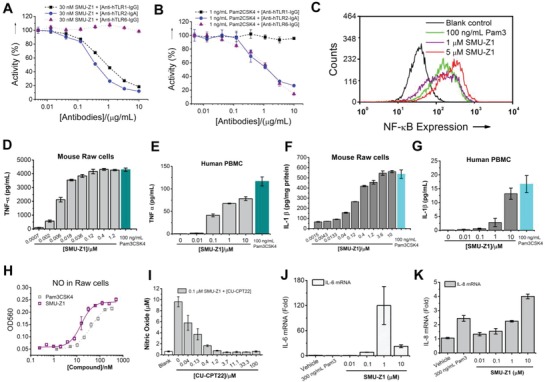Figure 2.

SMU‐Z1 is a TLR1/2, but not TLR2/6 agonist. A) HEK‐Blue hTLR2 cells were treated with SMU‐Z1 and anti‐hTLR1, anti‐hTLR2, or anti‐hTLR6 antibodies for 24 h. SMU‐Z1 strongly activates QUANTI‐Blue SEAP signaling at 30 × 10−9 m. Anti‐hTLR1‐IgG and anti‐hTLR2‐IgA antibodies inhibit SMU‐Z1‐triggered SEAP signaling in a dose‐dependent manner, whereas anti‐hTLR6‐IgG has no such influence. B) The positive control Pam2CSK4, a TLR2/6 agonist, had different responses to TLR1, 2 and 6 specific antibodies compared to SMU‐Z1. C) Flow cytometric analysis for 0 × 10−6, 1 × 10−6, and 5 × 10−6 m of SMU‐Z1 and Pam3CSK4. Results demonstrate excellent NF‐κB activation capacity of SMU‐Z1 compared to the positive control Pam3CSK4. D–G) SMU‐Z1 has stimulated D,E) TNF‐α and F,G) IL‐1β production in Raw 264.7 macrophage cells and human PBMC, respectively. H) SMU‐Z1 and Pam3CSK4 activate nitric oxide (NO) production in Raw cells in a dose‐dependent manner. I) NO activation of SMU‐Z1 can be inhibited by the TLR1/2 inhibitor, CU‐CPT22, in Raw 264.7 cells. SMU‐Z1 stimulates J) IL‐6 and K) IL‐8 mRNA production at different concentrations in human PBMC. Data are present as mean ± SD of triplicates and the results are representative of three independent experiments.
